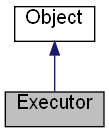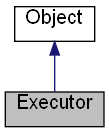
Inheritance diagram for Executor:


Public Member Functions | |
| Execute ([out, retval] VARIANT_BOOL *Result) | |
| Creates a new process and its primary thread. | |
| Wait ([in, defaultvalue(0xFFFFFFFF)] ULONG TimeOut,[out, retval] VARIANT_BOOL *Result) | |
| Waits for the process completion. | |
| Terminate ([in, defaultvalue(1)] ULONG ProcessExitCode,[out, retval] VARIANT_BOOL *Result) | |
| Terminates the process. | |
Properties | |
| BSTR RW | ApplicationName [] |
| The name of the module to be executed. | |
| BSTR RW | CommandLine [] |
| The command line to be executed. | |
| ULONG R | ExitCode [] |
| Retrieves the termination status of the process. | |
| BSTR RW | IntegrityLevel [] |
| Specifies usage of the Windows Integrity Mechanism. | |
| IDispatch *R | Error [] |
| If the process cannot be started, returns Error object. | |
| VARIANT W | OnComplete [] |
| Sets the event handler for the OnComplete event. | |
See also ExecutorEvents.
Example (JScript):
o = new ActiveXObject("Scripting.WindowSystemObject") ext = new ActiveXObject("Scripting.WindowSystemObjectExtensions") f = o.CreateForm(0,0,0,0) f.ClientWidth = 500 f.ClientHeight = 300 f.CenterControl() top = 10 for (i = 0; i<3; i++) { f.TextOut(10,top,"Process: "+i); status = f.TextOut(100,top,"") executor = ext.CreateExecutor() executor.CommandLine = "calc.exe" executor.UserData = status executor.OnComplete = function(Sender) { Sender.UserData.Text = "Completed/"+Sender.ExitCode } top += 30 if (executor.Execute()) status.Text = "Started"; else status.Text = "Error" } f.Show() o.Run()
| Execute | ( | [out, retval] VARIANT_BOOL * | Result | ) |
Creates a new process and its primary thread.
| Result | If "TRUE" - the process is started. |
| Terminate | ( | [in, defaultvalue(1)] ULONG | ProcessExitCode, | |
| [out, retval] VARIANT_BOOL * | Result | |||
| ) |
Terminates the process.
| ProcessExitCode | The exit code to be used by the process and threads terminated as a result of this call. |
| Result | If "TRUE" then the process is terminated. |
| Wait | ( | [in, defaultvalue(0xFFFFFFFF)] ULONG | TimeOut, | |
| [out, retval] VARIANT_BOOL * | Result | |||
| ) |
Waits for the process completion.
| TimeOut | Timeout in seconds. 0xFFFFFFFF = INFINITY. |
| Result | If "TRUE" then the process completed. |
| BSTR RW ApplicationName |
The name of the module to be executed.
The ApplicationName property can be empty string. In that case, the module name must be the first white space-delimited token in the CommandLine string.
If you are using a long file name that contains a space, use quoted strings to indicate where the file name ends and the arguments begin.
Otherwise, the file name is ambiguous. For example, consider the string "c:\program files\sub dir\program name". This string can be interpreted in a number of ways. The system tries to interpret the possibilities in the following order:
| BSTR RW CommandLine |
The command line to be executed.
The maximum length of this string is 32K characters.
If ApplicationName is empty string, the module name portion of CommandLine is limited to MAX_PATH characters.
The CommandLine property can be "". In that case, the Executor uses the ApplicationName string as the command line.
| ULONG R ExitCode |
Retrieves the termination status of the process.
| BSTR RW IntegrityLevel |
Specifies usage of the Windows Integrity Mechanism.
Gets or sets the integrity level for the process.
This parameter can be a one of the following values:
Note. If IntegrityLevel="" then the CreateProcess WINAPI function will be used, otherwise the CreateProcessAsUser.
Note. Only used in Windows Vista and later.
Example (JScript):
o = new ActiveXObject("Scripting.WindowSystemObject") ext = new ActiveXObject("Scripting.WindowSystemObjectExtensions") f = o.CreateForm(0,0,0,0) f.ClientWidth = 500 f.ClientHeight = 300 f.CenterControl() f.TextOut(10,10,"Integrity level:") integrityLevel = f.CreateComboBox(100,10,100,25) integrityLevel.Add("Untrusted") integrityLevel.Add("Low") integrityLevel.Add("Medium") integrityLevel.Add("High") integrityLevel.Add("System") label = f.TextOut(10,40,"") button = f.CreateButton(220,10,75,25,"Start") button.OnClick = function(){ executor = ext.CreateExecutor() executor.CommandLine = "notepad.exe" executor.IntegrityLevel = integrityLevel.Text executor.OnComplete = function(Sender){ label.Text = "Completed/"+Sender.ExitCode } if (executor.Execute()) { label.Text = "Started" } else { label.Text = "Error/"+executor.Error.Number+"/"+executor.Error.Description+"/"+executor.Error.Comment } } button = f.CreateButton(300,10,75,25,"Terminate") button.OnClick = function(){ executor.Terminate(10) } button = f.CreateButton(380,10,75,25,"Wait") button.OnClick = function(){ f.MessageBox("Wait result: "+executor.Wait()) } f.Show() o.Run()
| VARIANT W OnComplete |
Sets the event handler for the OnComplete event.
This event occurs when the process completed.